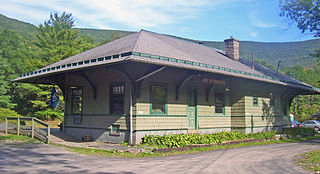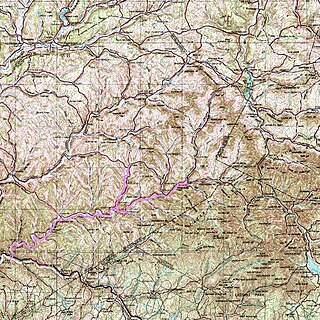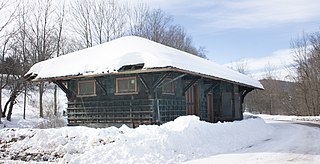
The Delaware, Lackawanna and Western Railroad, also known as the DL&W or Lackawanna Railroad, was a U.S. Class 1 railroad that connected Buffalo, New York, and Hoboken, New Jersey, and by ferry with New York City, a distance of 395 miles (636 km). The railroad was incorporated in Pennsylvania in 1853, and created primarily to provide a means of transport of anthracite coal from the Coal Region in Northeast Pennsylvania to large coal markets in New York City. The railroad gradually expanded both east and west, and eventually linked Buffalo with New York City.
The Ulster and Delaware Railroad (U&D) was a railroad located in the state of New York. It was often advertised as "The Only All-Rail Route to the Catskill Mountains." At its greatest extent, the U&D extended 107 miles (172 km) from Kingston Point on the Hudson River through the Catskill Mountains to its western terminus at Oneonta, passing through the counties of Ulster, Delaware, Schoharie and Otsego.

The Lackawanna Cut-Off was a rail line built by the Delaware, Lackawanna and Western Railroad (DL&W). Constructed from 1908 to 1911, the line was part of a 396-mile (637 km) main line between Hoboken, New Jersey, and Buffalo, New York. It ran west for 28.45 miles (45.79 km) from Port Morris Junction in Port Morris, New Jersey, near the south end of Lake Hopatcong about 45 miles (72 km) west-northwest of New York City, to Slateford Junction in Slateford, Pennsylvania near the Delaware Water Gap.

West Hurley, MP 9.8, later MP 10.2, was a railroad station on the Ulster and Delaware Railroad in West Hurley, New York that was constructed in the late nineteenth century and rebuilt during the construction of the Ashokan Reservoir. The original station was made of wood. It was later torn down and temporarily replaced with a board-and-batten shed close to Woodstock, which created much local indignation. A new brick station to replace it was constructed at the West Hurley Dike of the Ashokan Reservoir. The depot was torn down in 1967.
The Catskill Mountain Railroad is a heritage tourist railroad based in Kingston, New York, that began operations in 1982. The railroad leases a 4.7-mile portion of the former New York Central Railroad Catskill Mountain branch from Kingston to Stony Hollow, New York. The tracks are owned by Ulster County, New York, which bought them in 1979 from the bankruptcy estate of the Penn Central Railroad. The railroad's current permit with Ulster County expires on December 31, 2028.

Cold Brook is a former railroad station in the Boiceville section of the town of Olive, Ulster County, New York, United States. Located on Cold Brook Road, just north of New York State Route 28A next to Esopus Creek, Cold Brook station served the New York Central Railroad's Catskill Mountain Branch, formerly the Ulster and Delaware Railroad. The station was located 22.1 miles (35.6 km) northwest of Kingston Point station in the city of Kingston.

Phoenicia station is a repurposed train station located on High Street just south of Phoenicia, New York, United States. It is a frame building that opened in 1899.

The Delaware and Northern Railroad was a small railroad in Delaware County, New York, that was founded in 1905, and was planned to go from East Branch, where it would make a connection with the New York, Ontario and Western Railway, to Arkville, where it would connect with the Ulster and Delaware. This line ran close to the banks of the East Branch of the Delaware River, and had plans of expansion, but never made it far, only getting to Arkville. The line was scrapped in 1942, when the Pepacton Reservoir took over its right-of-way and forced the D&N to go out of business.

The station at Big Indian, MP 36.4, was another Ulster and Delaware Railroad station. It served the town of Big Indian, New York, and was at the bottom of the Pine Hill Grade. At this stop, a second or third locomotive was coupled to the train to help it up the grade to Grand Hotel station. A water tower was located here along with a turntable for turning steam locomotives.
Pine Hill station, MP 39.7 on the Ulster and Delaware Railroad (U&D), served the village of Pine Hill, New York. It was constructed on the slope of Belle Ayr Mountain 100 feet above the village along the steep grade running from Big Indian to the summit at Grand Hotel station. The famous double horseshoe curves on the U&D were located just west of the station.
Grand Hotel station, MP 41.4 of the Ulster and Delaware Railroad, was located in the small mountain hamlet of Highmount, New York, at the summit between Big Indian and Arkville. A turntable was located here, allowing pusher engines to be turned before descending to Arkville or Big Indian.

The station at Fleischmanns, New York, MP 44.1 of the Ulster and Delaware Railroad, was originally called Griffin's Corners station, as that was the town's original name. It was situated on a hill high above the busy town, and, like the town, was always very busy itself. Changes were made to the station when the New York Central purchased the line in 1932; a room was added on, and a chimney and a lookout room on the second floor were removed. The New York Central continued passenger service into the early 1950s, discontinuing it by early 1954. It survived even afterwards, but all that remains now is a freight house, which is used by the Delaware and Ulster Railroad.
The Arkville station, MP 48.1 on the Ulster and Delaware Railroad (U&D), and MP 37.52 on the Delaware and Northern Railroad (D&N), was another busy station, as this served as a junction between the two railroads. This station bore a strong resemblance to the Grand Hotel station and the Pine Hill station, which both looked like longer versions of the Mount Pleasant station.
Kelly's Corners station, MP 51.4 on the Ulster and Delaware Railroad, served a rural farming community, which there were plenty of in Delaware County.

Halcottville station, MP 53.0 on the Ulster and Delaware Railroad (U&D), served the hamlet of Halcottville. On February 1, 1932, the U&D became the Catskill Mountain Branch of the New York Central Railroad. In addition to the station, the U&D constructed a large ice-house here and stored ice from Lake Wawaka. A tiny steamboat, also named Wawaka, plied the lake during the summer months drawing visitors from up and down the line who rode the boat and picnicked on the shores of Lake Wawaka. Halcottville boasted a hotel, two creameries, an early electric light plant, several stores, a post office, dance hall, school, and several churches. There were also numerous boarding houses in the area.
Roxbury station is a disused train station on the former Ulster and Delaware Railroad / West Shore "Catskill Mountain Branch" in the hamlet of Roxbury, New York. The station is a contributing property to the Ulster and Delaware Railroad Depot and Mill Complex, a historic district on the National Register of Historic Places.
There were four stations built to serve the city of Kingston, New York. The first station was known as "Higginsville Station" built by the Rondout & Oswego railroad company. The second station was served by three different railroads, all of which eventually became part of the New York Central railroad company. The third station, known as "Fair Street Station", replaced the Higginsville Station in 1882. The fourth station was for the New York, Ontario and Western Railway.

The Cooperstown and Charlotte Valley Railroad Company is a heritage railroad in New York, operated by the Leatherstocking Chapter of the National Railway Historical Society (NRHS) since 1996.

South Gilboa station is a disused train station in South Gilboa, New York. The original station, at MP 70.4, was a spartan facility with a long platform on the end for ice from Mayham Pond, near the station, to be loaded onto freight cars. The ice would then be shipped to ice houses in Kingston, New York. However, this building was torn down by the Ulster and Delaware Railroad, and replaced with a new one in the early 1900s.
The Delaware and Ulster Railroad (DURR) is a heritage railroad based in Arkville, New York.










